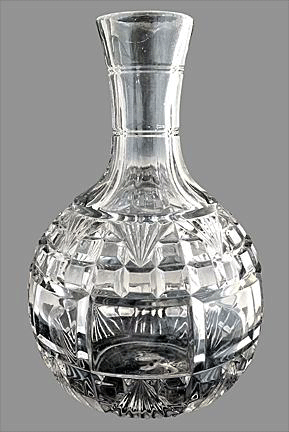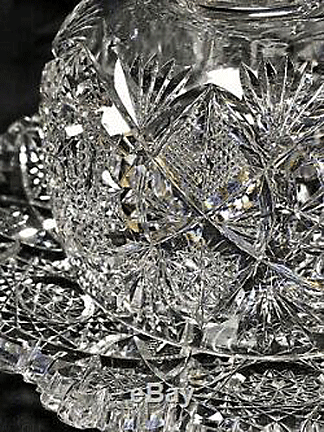|
The
Gleam of American Brilliant Glass
by
Bob Brooke
 American
Brilliant cut glass was a symbol of elegance in Victorian America from
around 1850 to the beginning of World War I. Middle class to wealthy
people liked to give pieces as wedding and anniversary presents.
Immigrants helped supply glass houses in the United States with skilled
cutters allowing them to develop a product rivaling European cut glass.
Prior to that time, most cut glass pieces came from England, France, and
Ireland. American
Brilliant cut glass was a symbol of elegance in Victorian America from
around 1850 to the beginning of World War I. Middle class to wealthy
people liked to give pieces as wedding and anniversary presents.
Immigrants helped supply glass houses in the United States with skilled
cutters allowing them to develop a product rivaling European cut glass.
Prior to that time, most cut glass pieces came from England, France, and
Ireland.
Early
History of Cut Glass
Historians trace the first cut glass to ancient Egypt in 1,500 BCE,
where artisans decorated vessels of varying sizes by cuts made by what
they believed to have been metal drills. Artifacts dating to the 6th
century BCE indicate that the Romans,
 Assyrians
and Babylonians all had mastered the art of cut decoration. Slowly glass
cutting moved to Constantinople, then on to Venice, and by the end of
the 16th century, to Prague. Apparently the art didn’t spread to the
Britain until the early part of the 18th century. Assyrians
and Babylonians all had mastered the art of cut decoration. Slowly glass
cutting moved to Constantinople, then on to Venice, and by the end of
the 16th century, to Prague. Apparently the art didn’t spread to the
Britain until the early part of the 18th century.
The New World didn’t see any cut glass until at least 160 years later.
Henry William Stiegel, an immigrant from Cologne, Germany, founded the
American Flint Glass Manufactory in Manheim, Pennsylvania, and it was
there in about 1771 that he produced the first cut glass in America.
 For
the next 60 years, the "Early Period" of American cut glass, pieces were
indistinguishable from English, Irish and continental patterns because
most of the cutters originally came to America from Europe. About 1830
American ingenuity and originality began to influence the industry, and
a national style began to emerge. This came about the time The United
States was preparing to celebrate her 100th birthday. and what
historians term the "Brilliant Period" began. From about 1876 until the
advent of World War 1, American cut glass craftsmen excelled all others
worldwide, and produced examples of the cut glass art that may never
again be equaled. For
the next 60 years, the "Early Period" of American cut glass, pieces were
indistinguishable from English, Irish and continental patterns because
most of the cutters originally came to America from Europe. About 1830
American ingenuity and originality began to influence the industry, and
a national style began to emerge. This came about the time The United
States was preparing to celebrate her 100th birthday. and what
historians term the "Brilliant Period" began. From about 1876 until the
advent of World War 1, American cut glass craftsmen excelled all others
worldwide, and produced examples of the cut glass art that may never
again be equaled.
 When
American glass manufacturers displayed their cut glass at the Centennial
Exposition in Philadelphia in 1876, their clear, bright, leaded glass
was an immediate sensation. From then on, American cut glass became
extremely popular. Most middle-class and wealthy households owned at
least a few pieces to grace their elegant holiday tables. When
American glass manufacturers displayed their cut glass at the Centennial
Exposition in Philadelphia in 1876, their clear, bright, leaded glass
was an immediate sensation. From then on, American cut glass became
extremely popular. Most middle-class and wealthy households owned at
least a few pieces to grace their elegant holiday tables.
Representatives from eight American glass manufacturers showed off their
leaded-crystal goblets, tumblers, decanters, and serving plates at the
Exposition. Each of these pieces had been deeply cut by hand on a
succession of metal, stone, and wooden wheels. The Brilliant Period
lasted from the Centennial celebration until the first decade of the
1900s, when changing tastes and less-expensive pressed glass, which
replicated the look of cut glass, pushed the original to the sidelines.
In fact, by 1910 manufacturers of the floral, fruit, and geometric
patterns in cut glass pressed their pieces first, then cut them, making
their pieces less costly to produce.

During the Brilliant Period,over1,000 cutting shops met the demand.
These shops turned thick, unadorned glass blanks into multifaceted
creationss, whose cut and engraved surfaces reflected light around a
room. Companies such Dorflinger, Hawkes, Libbey, J. Hoare and Co., T. G.
Hawkes, Tuthill, Egginton, and Mt. Washington
 were
highly regarded for the quality of their work, as well as their
artistry. Hawkes would go on to found Steuben with Frederick Carder,
while Libbey made Brilliant glassware for the White House. were
highly regarded for the quality of their work, as well as their
artistry. Hawkes would go on to found Steuben with Frederick Carder,
while Libbey made Brilliant glassware for the White House.
Some of the most sought-after patterns cut during the American period of
cut glass are Wedgemere, Aztec, and Ellsmere by Libbey; Aberdeen by
Jewel; Queens, Chrysanthemum, and Nautilus by Hawkes; Assyrian by
Sinclaire; Poppy by Tuthill; Wheat by Hoare; and Russian and Comet by
several companies. Shapes can also be considered rare, such as tea and
coffee pots, table lamps, oil lamps, triple-ring lapidary neck
decanters, cake plates, punch bowls, and whiskey bottles. Finally, while
many pieces were clear, some makers produced pieces in a variety of
colors, including ruby, green, blue, turquoise, and rainbow.
The
Process of Cutting Glass
 All
glass that is to be decorated by cutting requires the addition of up to
40 percent lead oxide, a chemical that makes ordinary glass soft enough
to cut against moving wheels without shattering. Leaded glass is called
"crystal.” All
glass that is to be decorated by cutting requires the addition of up to
40 percent lead oxide, a chemical that makes ordinary glass soft enough
to cut against moving wheels without shattering. Leaded glass is called
"crystal.”
Cutting glass was time
consuming. After a worker brought a blank from storage, a designer
marked it with outlines of the decoration. The "rougher" began the
cutting by holdng the blank against a rapidly moving, beveled, metal
wheel, kept constantly moistened and cooled by a fine stream of wet sand
dripping from an overhanging funnel. He followed the designer's marks,
making incisions by pushing the glass down against the wheel. A worker
would use various sized wheels to make the many different sized cuts
required to complete the design.

 Next,
the piece went to the "smoother", who went back over all the rough cuts
with stone wheels called "craighleiths." The smoother also initially cut
some of the small lines on the motifs, as indicated by the design.
Finally, the "polisher" finished the piece by polishing each cut with
wooden wheels made from willow, cherry or other softwoods. Rottenstone
or pumice was used with the polishing wheels to give a lustrous
appearance to the cut, leaving no imperfections on the gleaming
surfaces. Next,
the piece went to the "smoother", who went back over all the rough cuts
with stone wheels called "craighleiths." The smoother also initially cut
some of the small lines on the motifs, as indicated by the design.
Finally, the "polisher" finished the piece by polishing each cut with
wooden wheels made from willow, cherry or other softwoods. Rottenstone
or pumice was used with the polishing wheels to give a lustrous
appearance to the cut, leaving no imperfections on the gleaming
surfaces.
Early in the Brilliant Period one cutter did all cutting on a single
piece. Since changing wheels to accommodate various sizes and depths of
cuts could occupy sixty percent of a cutter's time, manufacturers
quickly adapted assembly line methods. Each cutter was given a different
sized wheel, and by passing a piece from station to station,
productivity increased immensely.
Artisans in over 1,000 shops cut hundreds of patterns. Some makers
polished glass using wooden wheels while others used acid. Hobstars and
fans, strawberry diamonds and flutes, beading and chair caning, are but
a few of the motifs that make up American designs. Not all cut glass was
of the same quality. While some was excellent, other pieces were just
fine, and many were downright inferior.
 Workers
cut facets into finished glass pieces by pressing them against a large
rotating iron or stone wheel. The nicest pieces of cut glass had a high
lead oxide content giving them extra sparkle showing off the exceptional
shine of the cutting in this clear glass. Workers
cut facets into finished glass pieces by pressing them against a large
rotating iron or stone wheel. The nicest pieces of cut glass had a high
lead oxide content giving them extra sparkle showing off the exceptional
shine of the cutting in this clear glass.
However, as ;the American Brilliant Period progressed, glassmakers
turned from hand blowing blanks to blown glass made with molds, and
eventually incorporated design elements in the blown mold as well.
However, craftsmanship suffered and the overall quality declined.
Manufacturers also changed how they polished pieces, going from hand
finishing to a strong acid bath to eliminate sharp edges. This method
worked but lacked the same high-quality finish when compared to the
earlier handcrafted glass. And to save money and increase profits,
decorations became less elaborate, with less swirled cuts and precise
points cut into the glass.
 Manufacturers
developed and patented stunning new patterns quite unlike earlier
European designs. They gave patterns intriguing names, and leading glass
houses began advertising campaigns urging collection of whole sets of
goblets, tumblers, wine glasses and finger bowls in the new designs.
Cutting shops proliferated to meet the demand for fine pieces of cut
glass being sought by wealthy American households. Manufacturers
developed and patented stunning new patterns quite unlike earlier
European designs. They gave patterns intriguing names, and leading glass
houses began advertising campaigns urging collection of whole sets of
goblets, tumblers, wine glasses and finger bowls in the new designs.
Cutting shops proliferated to meet the demand for fine pieces of cut
glass being sought by wealthy American households.
At the 1893 World's Columbian Exposition in Chicago, The Libbey Glass
Company of Toledo received top awards for cut glass with their Columbia
and Isabella patterns. Again popularity increased and huge sets of
American cut glass tableware were ordered by the White House, by the
presidents of Mexico and Cuba, by Edward VII of Great Britain, and by
many industrial tycoons of the day. American cut glass had reached the
zenith in its acceptance throughout the world. It had no peers.
The
Decline of American Brilliant Cut Glass
By 1908 less than 100 cut class workshops remained. A number of leading
companies continued to maintain their high standards throughout the
waning years, attracting the finest designers and most skilled
craftsmen, who from 1908 to 1915 produced some of the most elegant
patterns of cut glass ever created. One author has aptly referred to
this as the "Era of Super Glass."

The outbreak of World War I dealt the final blow to the fascinatingly
brief birth, growth and decline of a uniquely American achievement.
Brilliant cut glass. Lead oxide - an essential ingredient in glass made
for cutting was needed for more urgent uses, and by the time the war
ended, the few factories that had managed to survive used their
resources to produce less costly glass. Thus ended an era of Yankee
ingenuity, never to return.
<
Back to Antiques Archives
Next Article > |
